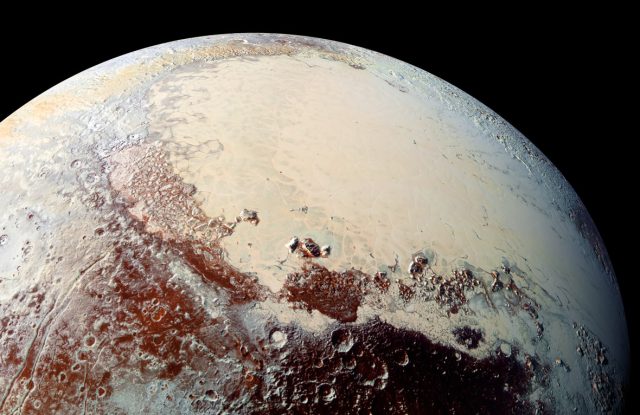
Three years ago, when the New Horizons spacecraft sped toward Pluto on July 4th and began sending humans their first clear images of the tiny world at the end of the Solar System, it all seemed preordained.
Of course NASA would fund and build a spacecraft to complete its initial survey of the Solar System and visit the only “planet” found by an American. (For the purposes of this article, we will set aside the debate over Pluto’s planethood.) But as ever in spaceflight, the end result almost invariably looks far simpler and smoother to the casual observer than the messy reality experienced by those actually doing it.
For example, anyone tuning in to watch a spacewalk on NASA TV will see splendid views of Earth in the background as two astronauts float around holding funny tools, slowly unscrewing this, or installing that. It all looks so easy. Yet those six or seven hours in space represent the culmination of years of training, and the EVA activity itself is as physically punishing for the astronauts in their bulky spacesuits as running a marathon.
Today, we can hardly think about Pluto and its moons without conjuring in our minds the iconic image of the reddish, brownish world that resembles nothing so much as a heart. The reality, however, is that we almost didn't get these images of Sputnik Planitia or Pluto's ghostly atmosphere. Rather, it seems a miracle that we did.
-
Taken on July 13, 2015. This is the last and most detailed image sent to Earth before the spacecraft's closest approach to Pluto on July 14. This gallery highlights some of New Horizons' discoveries.NASA/Johns Hopkins University Applied Physics Laboratory/Southwest Research Institute
-
This is the highest-resolution color departure shot of Pluto's receding crescent from NASA's New Horizons spacecraft, taken when the spacecraft was 120,000 miles (200,000 kilometers) away from Pluto.NASA/Johns Hopkins University Applied Physics Laboratory/Southwest Research Institute
-
One of the strangest landforms spotted by NASA's New Horizons spacecraft when it flew past Pluto last July was the 'bladed' terrain just east of Tombaugh Regio, the informal name given to Pluto's large heart-shaped surface feature.NASA/Johns Hopkins University Applied Physics Laboratory/Southwest Research Institute
-
Two different versions of an image of Pluto's haze layers, taken by NASA's New Horizons as it looked back at Pluto's dark side nearly 16 hours after close approach, from a distance of 480,000 miles (770,000 kilometers).NASA/Johns Hopkins University Applied Physics Laboratory/Southwest Research Institute
-
A closer view of Sputnik Planitia.NASA/JHUAPL/SwRI
-
Pluto's moon Charon (colors enhanced).
-
A newly discovered mountain range lies near the southwestern margin of Pluto’s Tombaugh Regio (Tombaugh Region), situated between bright, icy plains and dark, heavily cratered terrain.
-
A close up showing the jagged peaks of Pluto's Norgay Montes, some of which reach 3,500m. The late evening sunlight captures just how rugged this terrain is.
-
Pluto and its moon, Charon, are vastly different despite forming at the same time and place.NASA/JHUAPL/SwRI
-
A close zoom on the day/night border of the image reveals long, hazy shadows cast by the hills there. Pluto's atmosphere has a complex structure, with multiple layers, some of which form dense hazes.
-
Best image yet of Pluto's small moons, Nix and Hydra.
-
Pluto's Icy mountains and a surprising lack of impact craters nearby.
-
The ridges of Tartarus Dorsa.
-
Pluto’s first official surface-feature names are marked on this map, compiled from images and data gathered by NASA’s New Horizons spacecraft during its flight through the Pluto system in 2015.
This is the essence of the new book Chasing New Horizons, written by the principal investigator of the New Horizons mission to Pluto, Alan Stern, and his co-author David Grinspoon. The story of how New Horizons came to be is easily as compelling as the breathtaking imagery and discoveries it made.
Voyager and Pluto
NASA could have spied Pluto decades ago with the most iconic planetary science missions of all time, the Voyagers. Although the trajectory of Voyager 2 did not bring it near Pluto’s orbit, the Voyager 1 spacecraft could have reached the tiny world five years after its 1980 flyby of Saturn.
Mission scientists faced a dilemma: visit Titan or Pluto. They could either execute a maneuver immediately after passing Saturn that would bring the spacecraft near Titan; or they could skip a close Titan flyby, maneuver toward Pluto, and roll their dice on Voyager surviving for five more years. Ultimately Titan, with its tantalizingly thick atmosphere, won out. Few regret that decision today.
After the Voyagers, NASA was eager to send dedicated probes back to Jupiter and Saturn to better explore those complex worlds and their dozens of intriguing moons that the Voyagers had observed. These became the Galileo and Cassini probes. But Stern, a graduate student in the late 1980s, began to wonder why NASA wasn’t going to finish its exploration of the Solar System by sending a probe to Pluto.
He soon found (or arm twisted) a few scientific allies to join him in this cause—up-and-coming planetary scientists such as Fran Bagenal. As a first step, they decided to convene a session at the American Geophysical Union meeting in 1989. This would begin the process of building a consensus in the scientific community for such a mission.
Just before the meeting, Stern went to visit with Geoff Briggs, who then directed Solar System exploration for the space agency, at NASA Headquarters. In the book, Stern recalls telling Briggs, “With Voyager winding down, why don’t we complete the job of exploring the Solar System? Would you fund a study of how to do a mission to Pluto?”
Briggs was immediately enthusiastic. “You know, no one’s ever asked me about that before. It’s a wonderful idea, we should do that.” This would be the last real bit of enthusiasm Stern heard from NASA for a long time.
https://arstechnica.com/science/2018/07/inside-the-all-american-voyage-to-the-last-world-in-the-solar-system/Bagikan Berita Ini














0 Response to "Inside the all-American voyage to the last world in the Solar System"
Post a Comment